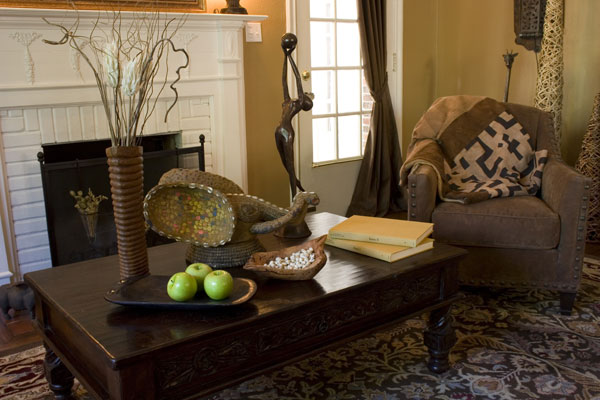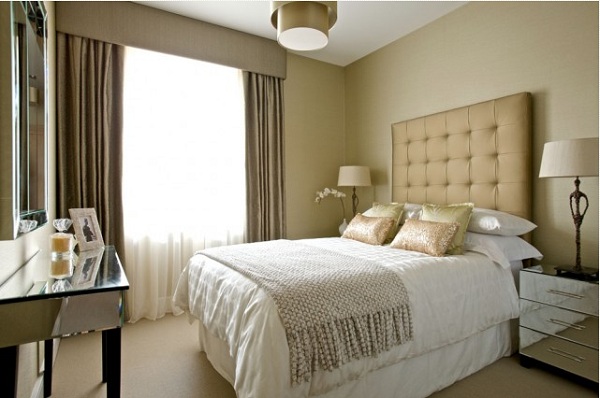Small interiors can be a real challengewith their design. The wrong color will provoke claustrophobia, too much furniture will create a feeling of chaos, and an inappropriate pattern may be too intrusive. Small interiors require their ownersingenuity Professional designers become illusionists of sorts when it comes to solving such problems. By adopting their favorite techniques, you yourself can perform an impressive trick, making everyone believe that a room in your house - very modest in fact - has enviable dimensions.
Small interiors require their ownersingenuity Professional designers become illusionists of sorts when it comes to solving such problems. By adopting their favorite techniques, you yourself can perform an impressive trick, making everyone believe that a room in your house - very modest in fact - has enviable dimensions.
1 Do not use dark shades
Have you ever been in rooms wherewhose walls are painted in a dark color, where both the carpet and the furniture induce gloomy thoughts? Isn't it true that such rooms seem to press you down, closing around the perimeter of impenetrable darkness? These are the properties of a dark palette, especially when it comes to compact spaces. A small room will only be attractive when it seems larger than it actually is. Light decor makes the walls "retreat", filling the interior with air and space. First of all, you should take a closer look at the most delicate shades of green, blue and gray, or turn to a neutral range.
2 Do not be afraid of bright colors
Many people don't even consider the possibilityusing rich colors in the decor of compact rooms. Meanwhile, the shortage of square meters is a great reason to experiment with bold colors. Limit the palette to a few especially favorite tones. Force yourself to decide to include spectacular floral patterns, graphic prints, horizontal or vertical stripes in the interior. Horizontal lines will visually expand the space, while vertical ones will create the illusion of high ceilings. Small interiors are more favorable to the presence of large-caliber drawings, since duplicate small images make them sloppy and flat.
3 Do not overlook the scale and proportions
Remember the tale of the three bears, in whichDid the girl who found herself in a forest hut choose a suitable bed for herself? The first one was too big, the second one was too high, and only the third one was just right. In the same way, the furniture should correspond to the dimensions of the room. A giant sofa will take up all the space in a small living room, while a too modest one will look comical. The ideal option is a balanced combination of large elements with small ones. Consider placing a high shelf or sideboard against the wall. Low chairs with narrow armrests or without them at all will make an excellent combination with a comfortable sofa.
4 Do not arrange the floor in a contrasting color.
The look of a person who finds himself in this place for the first timeroom, involuntarily lingers on the floor, then quickly embraces the walls, until it finally fixes on the ceiling. If all these surfaces are maintained in a single range, the interior is perceived as a single whole, and the boundaries of the planes are not visualized. An illusion of space and openness is created, and this is exactly what we expect from small rooms.
5 Do not overload the interior
Chaos and disorder are no better than dark walls,when it comes to the undesirable features of compact interiors. Entering a room cluttered with furniture, overloaded with decorative items and small details, you will inevitably feel the cramped space, its overwhelming energy and discomfort. To keep it as open as possible, choose a few things that are most dear to your heart and place them in strategic places. In moderation, fill the shelves, but not low surfaces like coffee tables.
6 Do not miscalculate with the movement pattern
Properly selected furniture also needs to bearrange so that everyone can move comfortably. This process will require patience and courage in decision-making. Move the sofa and armchairs away from the wall - the interior will gain visual depth. The more free space is left in the room, the more spacious it will seem. Do not cover the entire room with a rug, but buy a small carpet in the color of the flooring and place a furniture group on it - a seating area or a dining table with chairs.
7 Do not forget about lighting
Insufficient lighting turns a smallroom into a cave that causes claustrophobia. Ideally, the room should be provided with three light sources, and then it will look spacious and filled with air. If it is impossible to place table lamps and floor lamps, ask for help from sconces. And be sure to complement the image with mirrors, which will not only reflect light, but also visually expand the space by creating perspective.
8 Do not make window decoration too complicated.
Overly decorated windows are inevitableoverload the interior. Pompous curtains attract attention to themselves, instead of simply acting as an accent. The window frame should be laconic and delicate: it is better if it matches the wall decor, rather than contrasting.
9 Do not discount architectural details.
Walls without decor will not seemboring in the presence of stylish architectural elements. Interesting cladding and moldings, which we are used to seeing in solid rooms, will add significance to a small room, complicating its interior. Moldings, baseboards and beautiful panels will cope with this task perfectly.
10 Do not ignore vertical space.
Having finished the interior design and remainingWhile you're generally happy with the result, you may suddenly realize that the room lacks storage space. But walls aren't just there to be decorated with pictures. Make good use of vertical space by hanging a few shelves or installing built-in units. All these tips will help you create the illusionspace in a compact interior. Which of the recommendations presented here seemed most useful to you? Which do you disagree with? Share your opinion with us!
All these tips will help you create the illusionspace in a compact interior. Which of the recommendations presented here seemed most useful to you? Which do you disagree with? Share your opinion with us!


